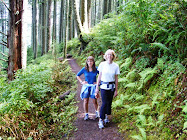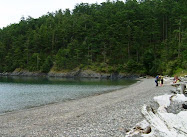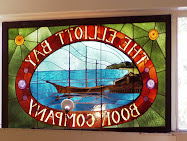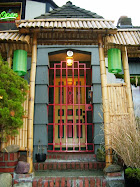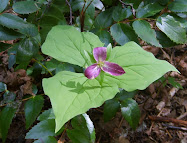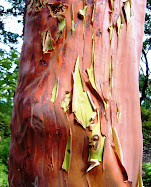 Ever been to Hurricane Ridge in Olympic National Park? Perched on the northernmost edge of the Olympic Mountains above Port Angeles, it's easy to get to and offers stunning views.
Ever been to Hurricane Ridge in Olympic National Park? Perched on the northernmost edge of the Olympic Mountains above Port Angeles, it's easy to get to and offers stunning views. But just a few miles eastward with even more spectacular, 360 views (and almost as easy to access) is much-less visited Deer Park.
A couple weeks ago I was fortunate to join Olympic National Park field scientist Bill Baccus on a morning trip up to Deer Park/Blue Mountain in the very northeastern corner of the park. Lucky me, the weather was sunny and mild, in fact just about perfect really.
Be forewarned that the drive up to Deer Park is a little harrowing if you're at all squeamish about heights. As driver Bill cheerfully told me about his work on the way up the one-lane, narrow dirt road with no guardrails and very steep drop-offs, I inwardly squelched my anxiety and looked straight ahead. Not down.
As a guest blogger for the Washington's National Park Fund, which is helping to fund the glacier monitoring program Bill leads, my goal was to learn about the program so far and report on it. The news isn't so great. (Read about it here.)
 |
| Carrie Glacier as seen from Blue Mountain. |
While Bill was off repairing a remote climate monitoring station near the Deer Park campground, I walked the Rain Shadow Loop trail at the summit of Blue Mountain, about a quarter-mile above.
 |
| View west of Klahhane Ridge and Mt. Angeles, road to Hurricane Ridge is the hillside cut. |
This short half-mile loop around the summit doesn't disappoint on a clear day.
Okay, that's an understatement. Views up there are fling your arms wide, twirl around, and sing like Julie Andrews or shout in euphoria for the panoramic beauty of it all. (Which I didn't do because I was too busy taking a billion pictures...but I thought about it.)
You can see north into Canada (Vancouver Island and B.C mainland), east to Cascade volcanoes such as Mt. Baker and elusive Glacier Peak, south deep into the craggy Olympic Mountains, and west up the Strait of Juan de Fuca.
 |
| South, (think) Obstruction Peak |
 |
| Southeast |
 |
| Eastward, Puget Sound visible in upper left. |
 |
| Northeast, Mt. Baker (Kulshan) in the distance. |
 |
| Tanker headed east on the Strait of Juan de Fuca. |
Some of the lichen, plants, and trees up here don't generally grow west of the Cascade Crest, such as lodgepole pine (which, like glaciers, are threatened by climate change).
Yes, there are a few longer and more rigorous hiking trails that head into the park wilderness from here. But this is what I had time for, and it thrilled me just the same.
Happy trails and thanks for visiting Pacific Northwest Seasons! And I'd love to hear in the comments below about your Northwest experiences.
In between blog posts, visit Pacific NW Seasons on FaceBook, Twitter, and Instagram for more Northwest photos and outdoors news.
When You Go
We're getting close to the end of the season to access Deer Park and Blue Mountain summit, but as of today the Deer Park campground was still open. From Highway 101 that runs along the northern peninsula, take the Deer Park exit just east of Port Angeles and head on up. When you reach the dirt road, you're within the national park boundary. It's 18 miles from Hwy 101 to the trailhead. Big rigs and trailers aren't recommended on the narrow gravel road to the top.





















































